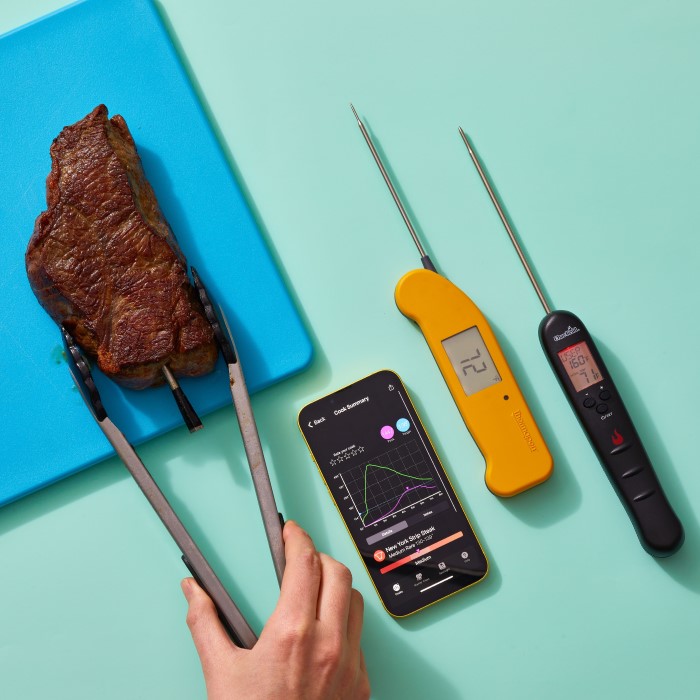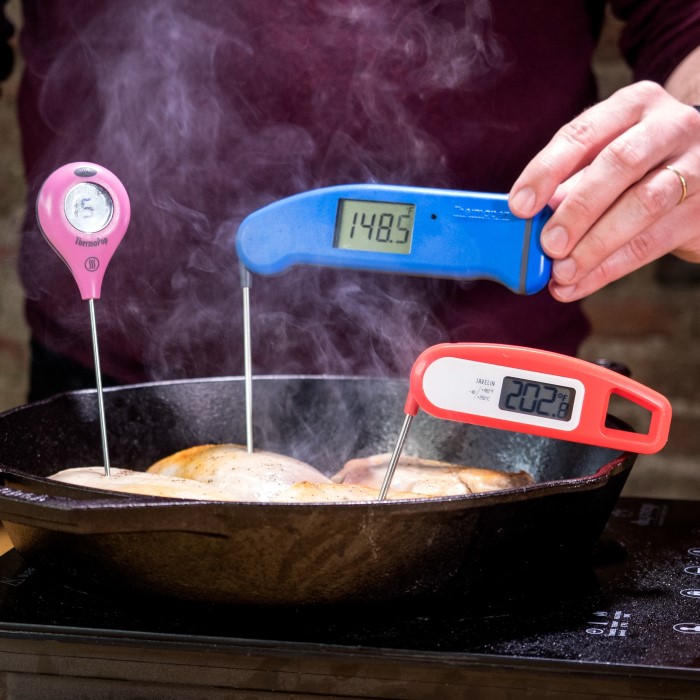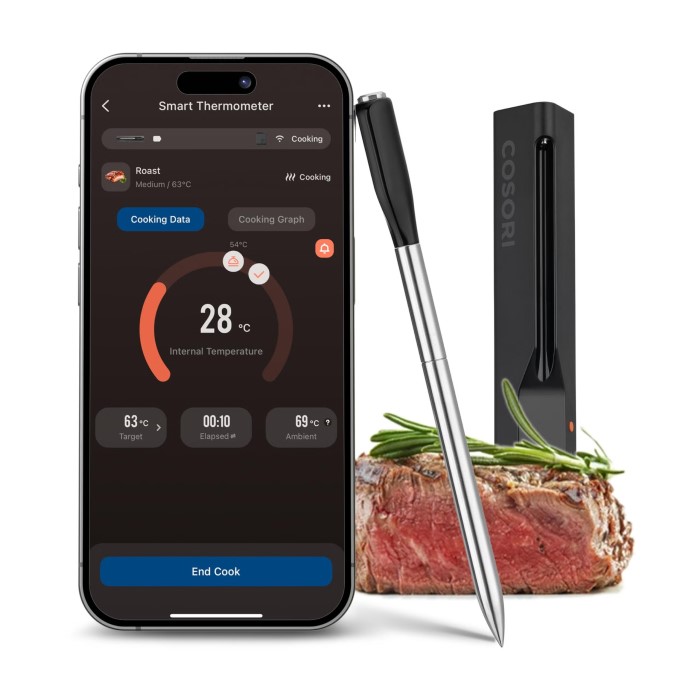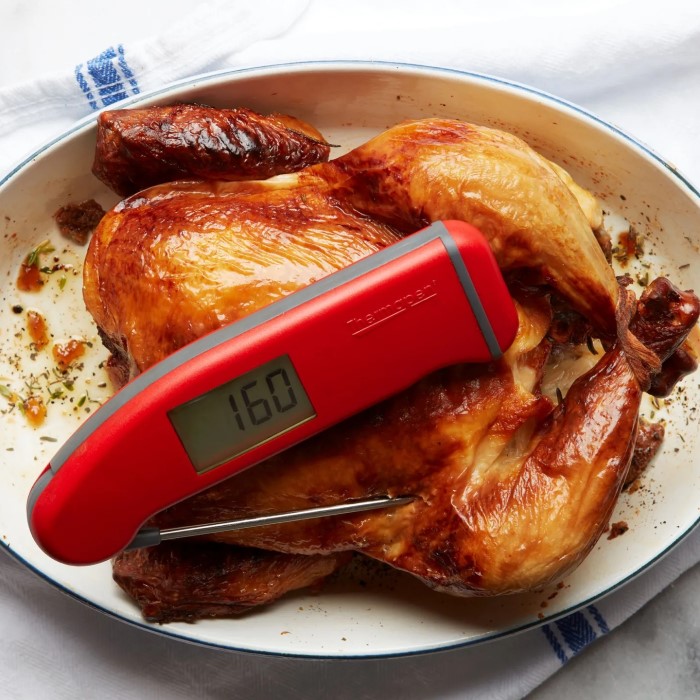Cooking is both an art and a science. Achieving the perfect dish often relies on precise temperature control. This is where the best digital thermometer for cooking comes into play. With the right thermometer, you can ensure your meats are cooked safely and your baked goods rise perfectly. Whether you’re a professional chef or a home cook, understanding how to choose the right thermometer can elevate your culinary creations.
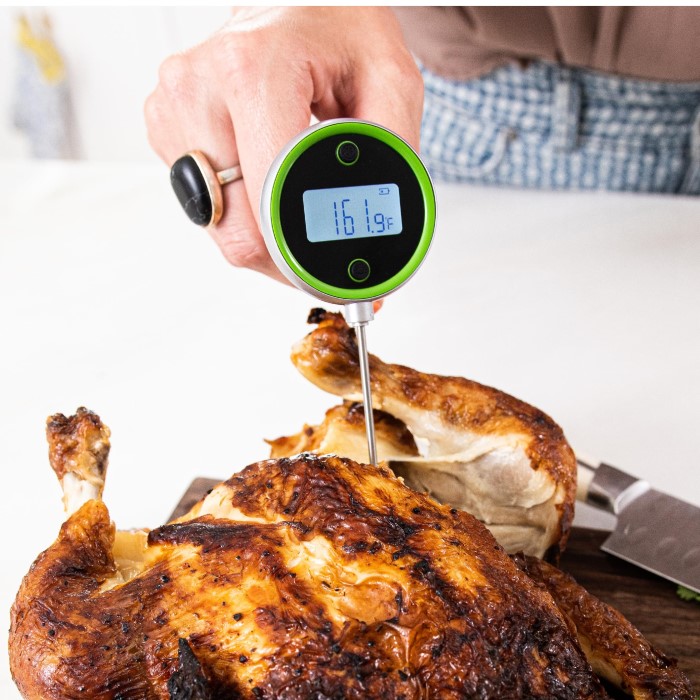
Why a Digital Thermometer is Essential for Cooking
Digital thermometers are invaluable tools in the kitchen. They help ensure food safety and consistent cooking. By providing accurate temperature readings, they take the guesswork out of meal preparation. Knowing their importance can elevate your cooking skills and protect your health.
Ensuring Food Safety Standards
A digital thermometer ensures that food reaches safe internal temperatures. This prevents harmful bacteria like Salmonella or E. coli from surviving in undercooked meals. For instance, chicken should reach an internal temperature of 165°F. By using a thermometer, you ensure every meal meets recommended safety standards. This step is vital for cooking meat, seafood, eggs, and even reheating leftovers.
Achieving Precise Cooking Results
Precision is key for perfect cooking. Overcooking can ruin texture and flavor, while undercooking leaves food unsafe. A digital thermometer provides exact temperature readings. This helps deliver juicy steaks, tender chicken, and flawless baked goods. Accurate readings also enhance consistency, ensuring every dish is cooked to perfection, every time.
Types of Digital Thermometers for Cooking
Understanding the different types of digital thermometers can help you choose the best one. Each type serves a unique purpose and fits specific cooking needs. Let’s explore.
Instant-Read Thermometers
Instant-read thermometers provide quick temperature readings. You can check your food in seconds. They are ideal for checking steaks, chicken, and fish during cooking. These thermometers are compact and easy to use. However, they may not stay in food during cooking.
Probe Thermometers
Probe thermometers are perfect for long cooking processes. They come with a metal probe connected to a digital display. Insert the probe before cooking and monitor the temperature continuously. Use them for meat, roasts, or oven-baked dishes. They offer convenience but require careful handling to avoid wire damage.
Infrared Thermometers
Infrared thermometers measure the surface temperature without contact. They are great for grilling or checking pan heat. These thermometers ensure precision when dealing with sauces or liquids. They are fast but not suitable for checking internal temperatures.
Key Features to Look for in a Digital Cooking Thermometer
Choosing the best digital thermometer for cooking involves evaluating its essential features. These features directly impact accuracy, ease of use, and versatility in cooking. Here’s what to consider:
Accuracy and Response Time
Accuracy is crucial for reliable temperature readings. A thermometer should provide precise readings within a small margin of error. Inaccurate devices can ruin both safety and taste. For quick checks, opt for thermometers with fast response times. A device that gives readings in seconds saves time and ensures efficiency. Look for models reviewed positively for both accuracy and speed.
Temperature Range
A wide temperature range allows for versatile cooking. From grilling to candy-making, different tasks demand different temperature requirements. A good thermometer should handle extreme lows and highs. Check if the device is suitable for your specific cooking needs, such as freezing levels or high-heat baking. Thermometers with adjustable settings may offer added flexibility.
Ease of Use and Cleaning
User-friendly thermometers simplify the cooking process. Seek models with easy-to-read displays and intuitive controls. Lightweight designs and ergonomic grips enhance comfort during use. Cleaning is also important for hygiene and durability. Choose thermometers made from materials resistant to food stains. Dishwasher-safe or waterproof models can further ease cleaning efforts.
By carefully considering these factors, you can select the best digital thermometer for cooking. A reliable thermometer will improve both safety and culinary precision.
Top Digital Thermometers for Cooking in the Market
Finding the best digital thermometer for cooking can be overwhelming due to numerous options. Each category offers unique choices for different needs, whether you’re on a budget or seeking high-end features.
Budget-Friendly Options
Budget-friendly thermometers are perfect for casual or beginner cooks. These models offer basic features like quick-read functionality and solid build quality. Popular options include compact instant-read thermometers with easy-to-read displays. They work well for foods such as steaks, chicken, or fish. Prices usually range from $10 to $20, making them accessible for most users. Although affordable, they may lack advanced features like wide temperature ranges or calibration functions.
Mid-Range Choices
Mid-range thermometers balance price and performance. These models often include improved accuracy, faster response times, and versatile applications. Probe thermometers tend to dominate this category, offering continuous monitoring for longer cooking processes. Some mid-range thermometers also feature smart connectivity for tracking via mobile apps. They typically cost between $20 and $50 and provide greater durability compared to budget options. Perfect for hobbyists seeking reliable tools without premium costs.
Premium Picks
Premium thermometers deliver advanced features, superior accuracy, and extended durability. These devices often include wide temperature ranges and specialized sensors. High-end models may have digital screens with customizable settings or Bluetooth for app integration. Common picks in this range include infrared thermometers, preferred for grilling or candy-making. Prices start around $50 and can exceed $100 for top-tier models. Professional chefs or serious cooking enthusiasts greatly benefit from these features. Despite being costlier, they ensure precision and performance for demanding tasks.
Comparing Digital Thermometers: Pros and Cons
Understanding the benefits and drawbacks of different digital thermometers can help you choose wisely. Let’s compare their features.
Instant-Read vs. Probe Thermometers
Instant-Read Thermometers:
Pros
- Quick Readings in Seconds
- Instant Results: Digital thermometers are designed to provide temperature readings almost instantly, typically within a few seconds. This feature is particularly useful when you need to check the doneness of your food quickly.
- Time-Saving: The ability to receive rapid readings helps streamline cooking processes, allowing you to make timely decisions without slowing down meal preparation.
- Compact and Easy to Use
- Portable Design: Many digital thermometers are lightweight and compact, making them easy to store and transport. You can easily fit one in a kitchen drawer or take it with you for outdoor cooking or barbecues.
- User-Friendly Interface: Most digital thermometers have simple controls and clear displays, making them accessible for cooks of all skill levels. Even beginners can quickly learn how to use them effectively without confusion.
Cons
- Cannot Stay in Food During Cooking
- Intermittent Monitoring: Unlike probe thermometers that can remain in the food while it cooks, digital thermometers typically require you to remove them after taking a reading. This means you need to monitor temperatures every few minutes, which can be less convenient.
- Risk of Heat Loss: Continuously opening the oven or grill to check the temperature can lead to heat loss, which affects cooking time and the final texture of the food. This aspect may require more attention during cooking.
- Less Suited for Long Processes
- Limited Use with Slow Cooking: Digital thermometers may not be ideal for long cooking processes, such as slow roasting or braising, where food is cooked over extended periods. You might need to check temperatures periodically, which can disrupt the cooking process.
- Inconsistent Readings: For food that requires a longer cooking time, repeatedly inserting and removing the thermometer can lead to inconsistent results, making it harder to ensure that the food reaches the desired internal temperature.
Probe Thermometers:
- Pros: Continuous temperature monitoring; ideal for roasts, meat, and oven dishes.
- Cons: Wires can be prone to damage; bulkier design compared to instant-read models.
Choose instant-read thermometers for faster checks and probe thermometers for extended cooking periods.
Infrared Thermometers vs. Traditional Options
Infrared Thermometers:
- Pros: Non-contact temperature readings; great for grilling, sauces, and liquids.
- Cons: Cannot measure internal temperatures; less effective for meat or bread.
Traditional Options:
- Pros: Reliable for precise internal temperature checks; versatile for most cooking tasks.
- Cons: Requires direct contact; slower compared to infrared models.
Pick infrared thermometers for surface checks and traditional ones for complete cooking accuracy.
Tips for Using and Maintaining Your Digital Thermometer
Proper usage and maintenance ensure the longevity and accuracy of your digital thermometer. Follow these tips for optimal performance.
Proper Calibration
Calibrating your thermometer ensures accurate temperature readings. Many devices allow manual or automatic calibration adjustments.
Check Manufacturer’s Instructions
- Consult the Manual: Always start by referring to the user manual that came with your digital thermometer. Each model may have unique features and specific calibration requirements.
- Follow Instructions Carefully: Pay special attention to any detailed steps laid out in the manual to ensure proper calibration. These instructions are designed to help you achieve accurate readings.
- Document Calibration Steps: If the manual suggests a series of steps for calibration, write them down or keep them handy to ensure you perform the calibration process correctly each time.
Use Ice Water Method
- Prepare the Ice Water Mixture: Take a clean glass and fill it about two-thirds full with ice.
- Add Cold Water: Pour cold water into the glass until it is full, ensuring that the ice floats on top and the water is very cold.
- Insert the Thermometer: Insert the probe of the thermometer into the ice water mixture, making sure not to touch the sides or bottom of the glass, as those may give inaccurate readings.
- Check the Reading: Wait for a few moments until the reading stabilizes. The thermometer should display a temperature of 32°F (0°C); this confirms that it’s accurate.
Test Using Boiling Water
- Boil a Pot of Water: Fill a pot with water and bring it to a rolling boil on the stovetop.
- Insert the Thermometer Carefully: Once the water is boiling, carefully insert the thermometer probe into the water. Avoid touching the pot’s sides or bottom, as this can affect the reading.
- Monitor the Temperature: Allow a few seconds for the thermometer to adjust and display a reading. It should read approximately 212°F (100°C) at sea level, which is the boiling point of water.
- Understand Elevation Effects: Be mindful that the boiling point of water can change based on elevation. If you live at a higher altitude, the boiling point may be lower.
Calibrate Regularly
- Establish a Calibration Schedule: Create a routine for checking your thermometer’s accuracy. Depending on usage, doing this once a month or before significant cooking events is advisable.
- Check for Inaccuracies: Pay attention to any inconsistencies in temperature readings during cooking. If you notice the thermometer provides results that seem off, it’s time to calibrate.
- Recalibrate Immediately: When inaccuracies are detected, promptly follow the calibration steps mentioned earlier to rectify the situation. This ensures you’re using an accurate thermometer for cooking.
- Maintain Consistency Over Time: Regular checks and calibrations contribute to the long-term reliability of your thermometer. Consistency in calibrating helps maintain precision, resulting in better cooking outcomes.
Cleaning and Storage Guidelines
Proper cleaning keeps your digital thermometer hygienic and functional. Correct storage extends its lifespan.
- Clean After Every Use: Wipe the probe with a damp cloth and mild detergent.
- Sanitize for Food Safety: Use alcohol wipes or food-safe sanitizers to disinfect the probe.
- Avoid Submerging Entire Device: Unless it’s waterproof, do not submerge the thermometer in water.
- Store Safely: Keep the thermometer in a protective case or designated storage space.
- Avoid Extreme Temperatures: Do not expose the device to excessive heat or cold during storage.
By following these practices, you ensure your thermometer remains reliable for years. Taking care of it benefits both its accuracy and durability.
Frequently Asked Questions About Digital Cooking Thermometers
How Often Should a Thermometer Be Calibrated?
Calibrate your digital thermometer regularly to ensure accurate readings. Frequency depends on use and type. For frequent use, check calibration monthly. High-precision cooking requires weekly calibration. Test after drops or temperature inconsistencies. Use methods like ice water (32°F) or boiling water (212°F). Always follow the manufacturer’s guidelines.
Can a Digital Thermometer Be Used for Liquids?
Digital thermometers work well with liquids if designed for it. Instant-read thermometers are ideal for soups or sauces. Probe thermometers can monitor liquid temperatures during cooking. Avoid using infrared thermometers for internal liquid temperatures—they measure only the surface. Always select models intended for your specific tasks to ensure reliability.
Conclusion: Making an Informed Decision
Choosing the best digital thermometer for cooking doesn’t have to be overwhelming. By focusing on essential features, understanding how to use thermometers effectively, and knowing the top options available, you can confidently make an informed decision.
Precision in cooking can greatly enhance your culinary outcomes, ensuring both safety and flavor. With the right thermometer and proper techniques, you can elevate your cooking game to a professional level. Make sure to consider the expert tips provided in this guide the next time you’re shopping for a digital thermometer. Happy cooking!
